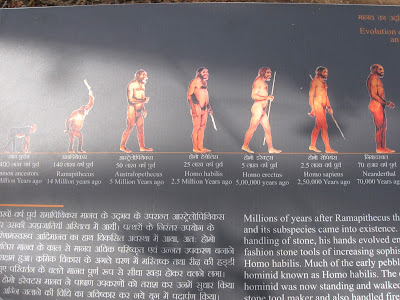A friend mentioned that she was planning to visit the famous rock shelters at Bhimbetka in Madhya Pradesh. These sandstone caves are famous for rock art and stone tools ranging in age from Paleolithic to more recent times. The site is looked after by the Archaeological Survey of India (ASI).
I remembered my own trip there over three years ago. Diving into my picture collection I came up with this gem. This plaque was in front of a cave where Paleolithic stone tools had been found. It describes the grand story of human evolution.
Underlined in yellow is the explanation for the evolution of our dexterous hands. I am not highlighting the language but the very Lamarckian-sounding mechanism. If the claim is that hands capable of making sophisticated tools evolved just by continuous handling of stone, then this is evolution occurring through inheritance of acquired characteristics. Just like a blacksmith passing on his musculature to his children. This is not a viable mechanism of evolution. Physiological changes acquired due to a life experience are not passed on to progeny. Our gametes are sequestered from our somatic cells. I strongly suspect that a lot of people still conflate inheritance of acquired characters with natural selection.
The very first sentence "Millions of years after Ramapithecus the species Australopethecus and its subspecies came into existence" is confusing too. As is another plaque which shows the classic linear march of hominin evolution from a more primitive looking ape to modern humans. In it, Ramapithecus appears to be an early ancestor of humans.
Australopithecus (genus, not species), did appear millions of years after Ramapithecus, but there is no ancestor-descendant relationship between the two. Ramapithecus was initially identified as a Miocene ape and a possible ancestor of humans. Its range was the Himalaya foothills, leading to some excitement that the human family roots can be traced to the Indian subcontinent. More fossil finds have changed this early interpretation. Ramapithecus is not even considered a valid taxon anymore. The fossils named Ramapithecus are now subsumed under the genus Sivapithecus. This latter genus includes a great variety of Asian ape species. The lineage is more closely related to the ancestors of the Orangutan and not to living African apes and the hominin family.
This is just a poor show by the ASI. They need to urgently upgrade the information they are providing the public.
I remembered my own trip there over three years ago. Diving into my picture collection I came up with this gem. This plaque was in front of a cave where Paleolithic stone tools had been found. It describes the grand story of human evolution.
Underlined in yellow is the explanation for the evolution of our dexterous hands. I am not highlighting the language but the very Lamarckian-sounding mechanism. If the claim is that hands capable of making sophisticated tools evolved just by continuous handling of stone, then this is evolution occurring through inheritance of acquired characteristics. Just like a blacksmith passing on his musculature to his children. This is not a viable mechanism of evolution. Physiological changes acquired due to a life experience are not passed on to progeny. Our gametes are sequestered from our somatic cells. I strongly suspect that a lot of people still conflate inheritance of acquired characters with natural selection.
The very first sentence "Millions of years after Ramapithecus the species Australopethecus and its subspecies came into existence" is confusing too. As is another plaque which shows the classic linear march of hominin evolution from a more primitive looking ape to modern humans. In it, Ramapithecus appears to be an early ancestor of humans.
Australopithecus (genus, not species), did appear millions of years after Ramapithecus, but there is no ancestor-descendant relationship between the two. Ramapithecus was initially identified as a Miocene ape and a possible ancestor of humans. Its range was the Himalaya foothills, leading to some excitement that the human family roots can be traced to the Indian subcontinent. More fossil finds have changed this early interpretation. Ramapithecus is not even considered a valid taxon anymore. The fossils named Ramapithecus are now subsumed under the genus Sivapithecus. This latter genus includes a great variety of Asian ape species. The lineage is more closely related to the ancestors of the Orangutan and not to living African apes and the hominin family.
This is just a poor show by the ASI. They need to urgently upgrade the information they are providing the public.



Lamarckism, with a twist, has re-entered biology. For the last few years, I have seen quite a few reports on how epigenetic modifications can also be transmitted from one generation to the next.
ReplyDeleteYeah I did come across few articles too. From what I've read though, this is really not news to evolutionary biologists
ReplyDeleteHere is some interesting reading from a biochemist I follow- https://sandwalk.blogspot.com/2017/05/debating-philosophers-epigenetics.html . I don't claim to understand all the details, except that many biologist don't really think that epigenetics is that big a deal in evolution.